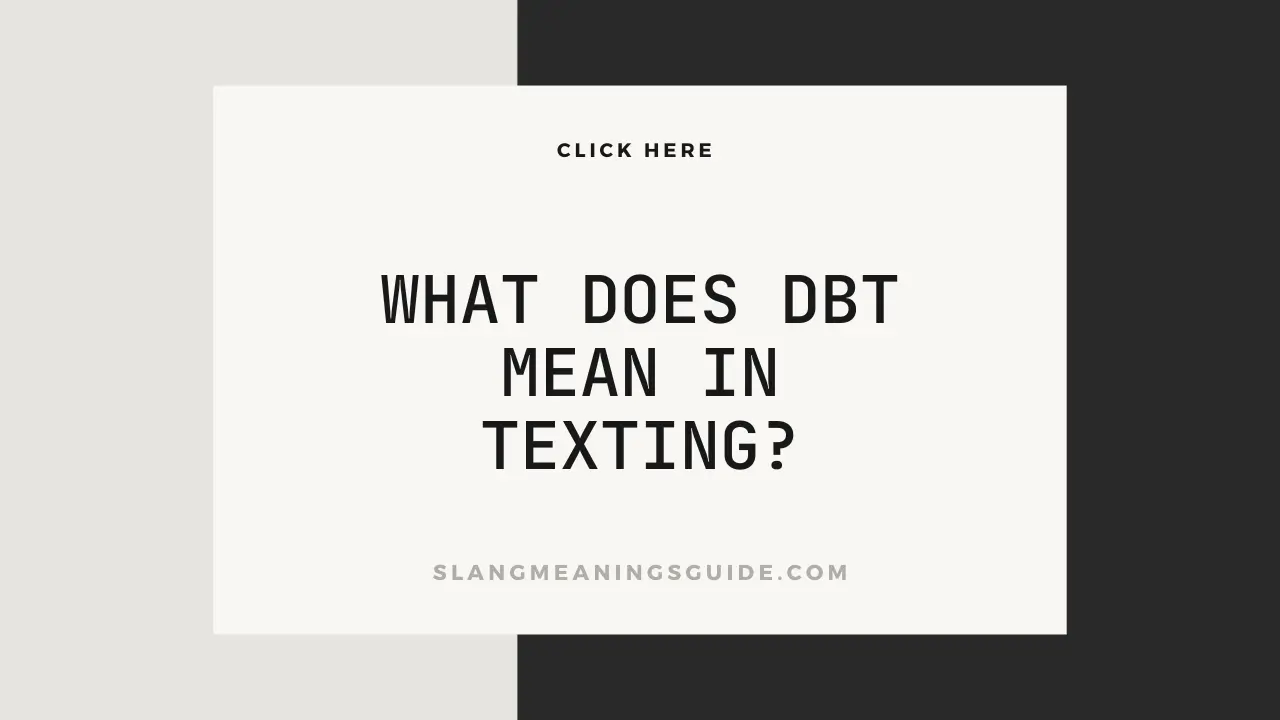In this era of messaging and fast-paced lives, abbreviations have become a vital component of the language. They range from LOL to OMG but help people to communicate more quickly and effectively. Another abbreviation that has gained a lot of popularity in recent years is DBT. However, what does DBT really mean?
DBT has developed a whole new meaning. In this short time, this single abbreviation has created several different definitions. In this article, we will explore some popular meanings of DBT in a text message.
What Does DBT Mean in Texting?
When it comes to texting, DBT becomes something other than a static label. Its use in non-formal text messages helps illustrate the fluidity of acronyms in digital messaging, with its plural and adaptable meaning.
Firstly, “Don’t Bother Texting,” a direct admonition often used in situations of frustration or finality in conversations, signals a boundary or an end to dialogue. Conversely, “Don’t Be There” serves as a warning or advice, possibly in jest or with serious intent, about avoiding certain situations or gatherings.
The third, most generative of all draws back to its psychotherapeutic roots: ‘Dialectical Behavior Therapy,’ where DBT stands for emotional support or self-care. Again, the examples are endlessly creative: a spurned lover texting ‘DBT’ to signal to end a name-calling conversation; three friends texting ‘DBT’ in unison to chide another friend against attending a notorious party.
Origin of DBT in Texting:
Examples of using DBT:
Alternate meanings of DBT:
Understanding Dialectical Behavior Therapy (DBT)
Dialectical Behaviour Therapy (DBT) was developed by Marsha Linehan in the late 1980s as a comprehensive cognitive-behavioural therapy for patients suffering from borderline personality disorder (BPD). Developed as a treatment for borderline personality disorder, DBT has since been adapted to treat a range of mental health issues, such as depression, anxiety, and PTSD.
DBT integrates standard cognitive-behavioral techniques for emotion regulation and reality . Rooted in Buddhist meditative practice, DBT can help people reach a “dialectical” position of acceptance and change. A cognitive-behavioral therapist would teach you to manage your emotions and foster reality testing. In contrast, a DBT therapist helps you do that by bringing in mindful awareness, distress tolerance, and acceptance. It can be beneficial for people with intense emotions that they don’t know how to deal with.
You can then tide them over in daily life by including DBT concepts in regular conversation, texting, and so on. You’re creating a culture where mental health topics are talked about and getting help is accepted. It’s another step to making therapy and emotional well-being more significant parts of everyday culture and reducing the stigma.
How Texting is Changing the Way We Talk About Mental Health
The Question: What effect does texting have on mental health? To start, texting has helped bring mental health into conversation. Now many people can communicate through messaging apps on their smartphones such as WhatsApp, Facebook, or Snapchat, rather than talking over the phone. It is expected to see people sharing feelings about their inner state and mental health through these platforms. The same can be said for social media platforms and online forums.
Firstly, texting provides a sense of distance that makes disclosures easier, other advantages include being able to reach out to someone for support at any time, from anywhere, and they don’t have to be with you in person to receive help. Also, Texting provides access to a range of mental health resources, such as online therapy platforms, mental-health apps such as Headspace, Talkspace, and Better Help, and peer-to-peer support.
Yet it is also important to admit that the heavily reliant use of text in such discussions might bring about some potential shortcomings. The minor absence of nonverbal cues and tone can eventually lead to misunderstanding and miscommunication.
Challenges and Misinterpretations
Abbreviations such as DBT leave room for interpretation and might be misunderstood, especially by those who are less familiar with mental health jargon, mainly what ‘DBT’ could be short for in any given situation (DBT has been interpreted as a simple typo or another full term in different contexts).
Furthermore, using texting to discuss difficult subjects—including mental health—further complicates the potential for misinterpretation because so many cues usually present—vocal tone among them—are unavailable through typing. The simple fact is that texting is always contingent on context. It is always incumbent on both parties to request clarification when at a loss about what is conveyed. If the plethora of acronyms can abbreviate many a back‑and‑forth, they won’t replace face‑to‑face communication, especially around complex subjects such as mental health.
Conclusion
In conclusion, DBT is a versatile abbreviation that has evolved beyond its roots and become modern texting slang. Its multiple meanings, from “Don’t Bother Texting” to “Dialectical Behaviour Therapy,” reflect the dynamic nature of language and the digital age.
As we navigate the complexities of digital communication. It’s essential to recognize the challenges and misinterpretations that can arise from using DBT and other abbreviations. Ultimately, the meaning of DBTin slang is very creative and resilient to human communications.

